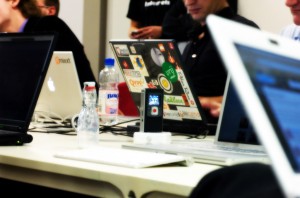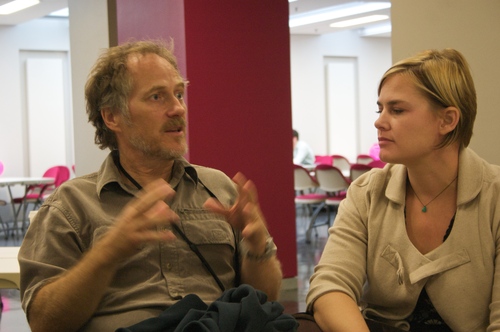Now, back from an intense Berlin Web Week, it’s time for an after-action review. Let’s see, been to the BarCamp Berlin, pl0gbar, Girl Geek Dinner (sic!), Lunch 2.0 at plista and the Web 2.0 Expo Europe.

Mingled with the crowd, had fun at parties and more. Blogged at times, tweeted a lot, tagged stuff with #berlinblase and #w2eb when I deemed it fit.
Overall this was fun and gave me some insights too, like e.g. when sitting together with Tim O’Reilly and his team or when talking shop with the fellow participants, some speakers and exhibitors.
During the Expo, I had the chance to check out some vendors like Jive Software, telligent and Zoho. Yes these were in my portfolio of suitable (and “to watch”) software already, but it’s always nice to talk to the (sales) people directly. Others were around too, but hey, time was scarce these days (and my plan to talk to introduce me to Jeffrey Walker on the last day of the Expo failed for objective reasons).

Image by Luca Sartoni who caught me and my laptop during the blogger roundtable (licensed under CC: some rights reserved)
I blogged some of my thoughts and notes on the events I’ve been here already, as well as notes on the keynotes. Let me pull something to the front once more, because (Tim’s main point) is so important: if you are going to do something, do something that matters. We’ve got lots of problems and opportunities at hand, that might be tackled by cleverly using technology. And organizations (smallish ones, yes, but also big corporations) are mighty levers to change the world for the better.
Therefore I am feeling a bit disappointed after the Expo – I feel that not many CxO type of guys were present (CIOs weren’t there either, but that’s a different story). This is both sad and telling, on a wide scale and in direct relation to intra-company workings. Enterprise 2.0 will effect big changes in the corporate world, and it has great impact on companies’ competititveness. Given that the cover of the October issue of the german language Harvard Business manager is “IT – new technologies are changing business administration” this little response from german CxOs is feeling awkward. And they didn’t go to the Systems 08 either, so my point is clear: “Doesn’t Web 2.0 in the Enterprise matter to them?” and “What to do about that?”




